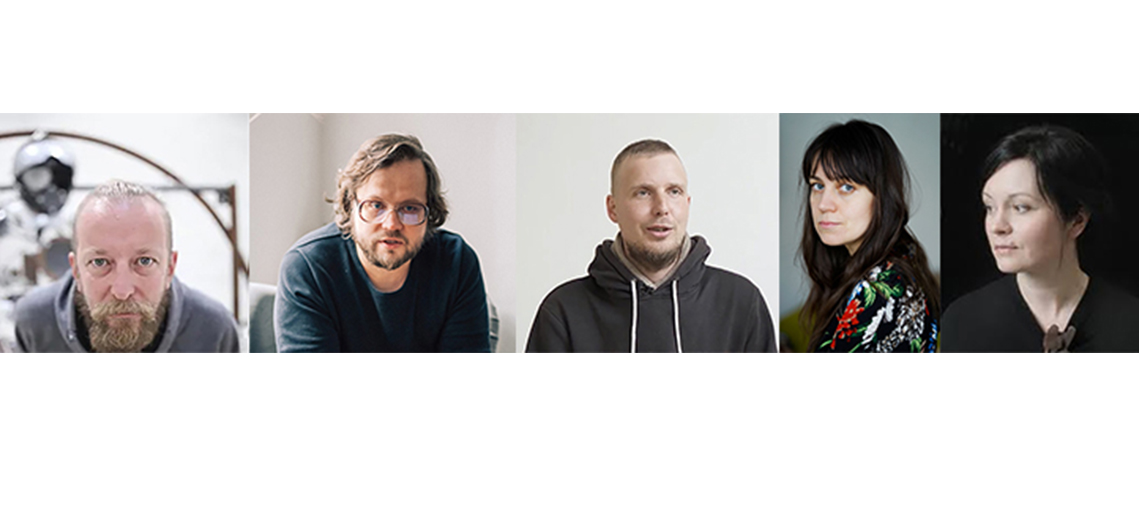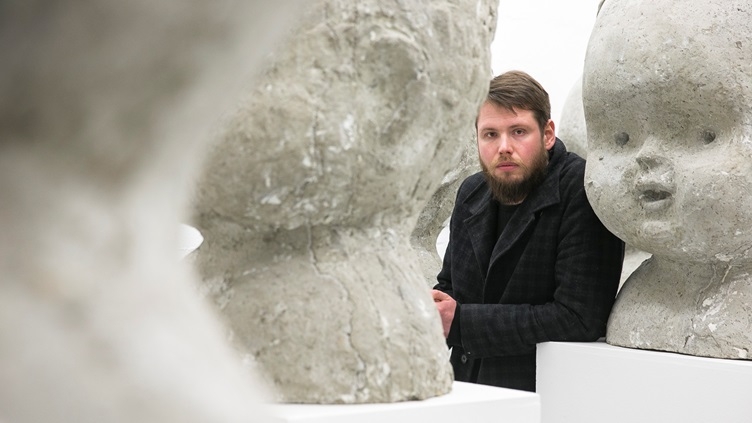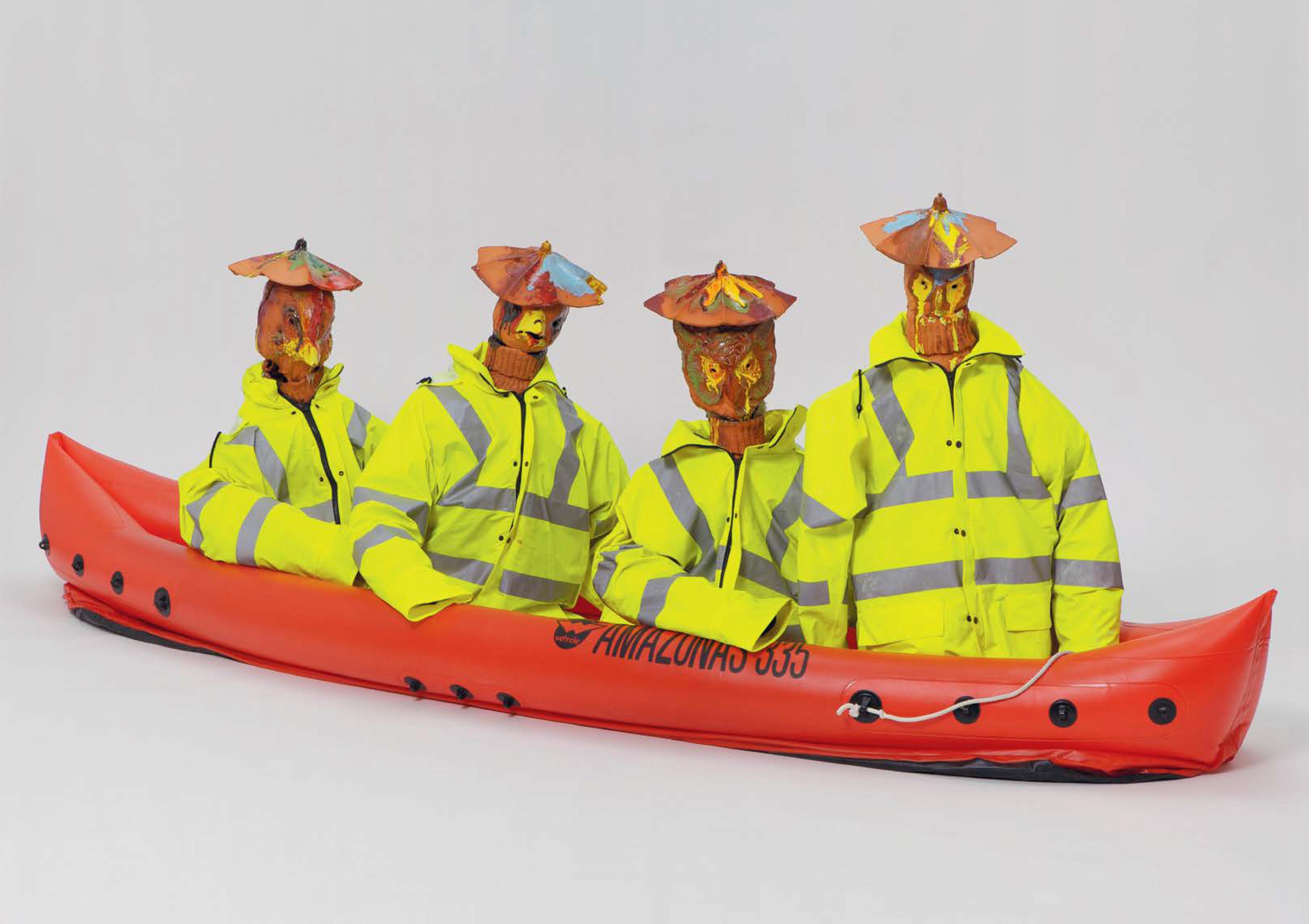Breadcrumb
Artist laureate salary
Artist Laureate Salaries 2020–2022
Estonian Artists' Association received 53 applications by the deadline for submitting applications on November 4, 2019. The EAA committee consisting of the following members – Elin Kard and Vano Allsalu (Estonian Artists' Association), Sirje Helme (Art Museum of Estonia), Joanna Hoffman (Tartu Art Museum), Marten Esko (Contemporary Art Museum of Estonia), Tamara Luuk (Tallinn Art Hall), Maria Arusoo (Estonian Center for Contemporary Art), Kai Lobjakas (Estonian Museum of Applied Art and Design), Peeter Talvistu (Tartu Art House), Kadri Laas-Lepasepp (Estonian Contemporary Art Development Center) and artist Kaido Ole (grantee of the Artist Laureate Salary in 2016–2018) – decided to award artist laureate salary for 2020–2022 to the artists Merike Estna, Raul Keller, Karel Koplimets, Paul Kuimet and Kristina Norman.
Merike Estna (b. 1980) is an artist who lives and works in Tallinn. She has studied at the Estonian Academy of Arts and Goldsmith College, London. In her creative practice, Merike Estna focuses on examining the painting process through which the artist approaches art as an inseparable part of life. The keywords of her painting style are unusual patterns and colour combinations that often derive subject matter from the field of applied art. In 2014, Estna received Konrad Mägi Art Award; she is one of the most active Estonian artists in the international art field. Besides numerous domestic and international private collections, Estna's artwork is also owned by Kumu Art Museum and Tartu Art Museum. See also: http://www.genialmythcraft.com
Raul Keller (b. 1973) has practised various types of interdisciplinary art since 1990s – sound installation, performance, photography, DIY-culture, text, video and radiophonic art. Besides personal exhibitions the artist has also held radio art concert performances with LokaalRaadio and with free-impro noise duo Post Horn. As an Anglo-American artist Paul Cole, Keller has performed burlesque Americana. Raul Keller is also a founding member and head of Dynamic Union of Music and Arts as well as participating in art group MIMproject. Raul Keller and Katrin Essenson have founded radio art festival „Radiaator“. Keller's artwork belongs to several private art collections as well as the collections of the Contemporary Art Museum of Estonia, Art Museum of Estonia and Tartu Art Museum. See also: https://raul.keller.ee
Karel Koplimets (b. 1986) is an artist who works with narrative installations while being inspired by the following themes: conspiracy theories, crime, mechanisms of fear, paranormal phenomena and paranoias. His artwork can be also characterized by the keywords of investigation and case study. Koplimets has obtained MA degree in the department of photography at the Estonian Academy of Arts, he has also taken additional courses on photography at the Academy of Performing Arts in Prague. Koplimets is a member of artist collective Visible Solutions LLC, he has participated in numerous exhibitions both in Estonia and abroad. His artwork belongs to the collections of Art Museum of Estonia, Tartu Art Museum, Contemporary Art Museum of Estonia, Museum of Contemporary Art Kiasma and Musée de l’Elysée.
See also: http://www.karelkoplimets.com
Paul Kuimet (b. 1984) is an artist who works with photography and 16mm film involving mainly spatial installations. His artwork can be characterized by the mode of looking specific to technology and technical mediation. Kuimet is intrigued by iconic modernist buildings and objects as well as contemporary non-places that may incur visual allusions to 20th century avant-garde in art and architecture that is now completely devoid of these utopian aspirations and meanings. Kuimet has studied photography and video art at the Estonian Academy of Arts; Aalto University School of Arts, Design and Architecture (TaiK); Baltic Film, Media and Arts School of Tallinn University (BFM) and University of East London. Kuimet has also enhanced his artistic practice in residences of the Väino Tanner Foundation, Espace Photographique Contretype, Atelierhaus Salzamti and WIELS Centre for Contemporary Art.
See also: https://paulkuimet.ee
Kristina Norman (b. 1979) is an artist whose interdisciplinary artwork can be characterized by the artist's interest towards the relationship between identity, memory and public space. Norman works both with contemporary art and documentary filmmaking. She has obtained BA degree in the department of printmaking and MA degree in the faculty of fine art at the Estonian Academy of Arts. In 2009, Kristina Norman represented Estonia at the 53rd Venice Biennale with the project „After-War“. With her newest artwork, Norman addresses the hot spots of migrations while focusing on memory and public opinon and using the performative means of research-based art. Kristina Norman is an artist-in-residence in the oldest festival of performing arts in Italy „Santarcangelo dei Teatri“.
Artist Laureate Salary 2021–2023
Estonian Artists' Association received 50 applications by the deadline for submitting applications on November 16, 2020. The EAA committee consisting of the following members – Elin Kard and Vano Allsalu (Estonian Artists' Association), Sirje Helme (Art Museum of Estonia), Joanna Hoffman (Tartu Art Museum), Laura Toots (Contemporary Art Museum of Estonia), Paul Aguraiuja (Tallinn Art Hall), Maria Arusoo (Estonian Center for Contemporary Art), Kai Lobjakas (Estonian Museum of Applied Art and Design), Peeter Talvistu (Tartu Art House), Kadri Laas-Lepasepp (Estonian Contemporary Art Development Center) and artist Marko Mäetamm (grantee of the Artist Laureate Salary in 2019–2021) – decided to award artist laureate salary for 2021–2023 to the artists Eike Eplik, Anders Härm, Tiina Sarapu, Jevgeni Zolotko, Sigrid Viir.
Eike Eplik (b. 1982) is a sculptor and installation artist who applies motifs from nature and sculptural techniques varying from classical plaster moulding to wooden assemblages and found objects, while being based on the principles of improvisation. Eplik has graduated from the department of sculpture at Pallas University of Applied Sciences and obtained MA degree in the department of sculpture at the Estonian Academy of Arts. During her studies, Eplik has trained with various artists in Germany and Finland. Eike Eplik works as a teacher at Children Art School of Tartu and as a lecturer at Pallas University of Applied Sciences. She has received Eduard Wiiralt Scholarship and Ado Vabbe Art Award. In 2012, Eike Eplik was awarded the Young Artist Production Grant of the art festival ART IST KUKU NU UT and in 2015 she was a nominee of Sadolin Art Award.
See also: https://eikeeplik.ee
Anders Härm (b. 1977) is an art historian, curator and lecturer. Härm has graduated from the Institute of Art History and Visual Culture at the Estonian Academy of Arts. He is a freelance curator, lecturer and head of the curriculum of curatorial studies at the Institute of Art History and Visual Culture at the Estonian Academy of Arts.
Anders Härm is a co-founder and member of the board of the Contemporary Art Museum of Estonia (EKKM) and was the manager of the museum in 2009–2015. In 2002–2012, Andres Härm worked as a curator at Tallinn Art Hall. Among his recent curatorial projects, the most promiment ones have been Ando Keskküla's retrospective exhibition „Technodelia and Reality“ in Kumu Art Museum (2020), international group exhibition „Xenos“ in Contemporary Art Museum of Estonia (2019) and „The X-Files [Registry of the Nineties]“, co-curated with Eha Komissarov in Kumu Art Museum (2018). Härm has curated projects in Estonia, Germany, Slovenia, Norway and Finland. He also curated the Estonian national pavillion at the International Architecture Exhibition in Venice (with Tarmo Maiste, 2000) and in International Art Exhibition in Venice (2003). Anders Härm is a co-founder of NU Performance Festival (with Priit Raud). In 2009, Härm published a collection of essays and texts „Dairy of a Semionaut“. He has also staged three solo lectures, worked as a playwright, written texts in culture magazines and made documentary films.
Tiina Sarapu (b. 1971) is a glass artist who mainly works with glass as the basic material for making her installations and sculptures as well as for creating the spatial form. Sarapu mediates her creative ideas through working with reflections, transparency and simple flat glass. She has obtained MA degree from the department of glass art at the Estonian Academy of Arts in 1996. Sarapu has worked as a lecturer (1996–2003) and an associate professor (2003–2017) in the department of glass art at the Estonian Academy of Arts. Since 2017 working as a freelance artist.
Tiina Sarapu has participated in numerous exhibitions, symposiums and workshops in Estonia and abroad. Her artworks are owned by several museums and private collectors. She has received honorary nominations for the titles of „Recognized Glass Artist 2004–2005“, „Recognized Glass Artist 2018–2019“; also, she was awarded Kristjan Raud Art Prize in 2007 and the Annual Award of the Cultural Endowment of Estonia in 2019. Tiina Sarapu has also received attention at several international contests of glass art. She has created several site-specific installation and made several honourable awards using glass. Besides her artistic practice, Sarapu has also curated several exhibitions.
See also: https://tiinasarapu.ee
Jevgeni Zolotko (b. 1983) is an artist who is intrigued by the interrelationship between verbal and tangible material. With his site-specific installations, Zolotko brings forth the universal features of human nature. The artist is interested in the perception and suppressed subconsciousness inherited through culture and religion while diving in his artwork into the past that existed before collective consciousness. Jevgeni Zolotko has graduated from the Pallas University of Applied Sciences and from the department of sculpture and installation at the Estonian Academy of Arts. Zolotko has been acknowledged with Köler Prize 2011 by the Contemporary Art Museum of Estonia (EKKM), Anton Starkopf Sculpture Prize in 2012, the Annual Award by the Cultural Endowment of Estonia 2013, honorary nomination title of Tartu City Culture Award 2016 and the Art Award by magazine „Akadeemia“ in 2017. Since 2017, Zolotko has worked as a lecturer in the department of landscape architecture at the Tallinn University of Technology and in the department of sculpture and installation at the Estonian Academy of Arts. His artworks are owned by the Art Museum of Estonia and Tartu Art Museum as well as by private collectors.
Sigrid Viir (b. 1979) is a photo and installation artist. In her artistic practice, Viir often works with social agreements, moral norms and regulations in society while examining the essence and borderlines of photography as a means of art. Viir has stated that as an artist she finds it important to question self-explanatoriness, ask questions, examine behavioral habits and observe self-presentation in both public and private context. Sigrid Viir has graduated from the department of photography at the Estonian Academy of Arts and taken additional courses in the programme of media art at Karlsruhe University of Applied Sciences, Germany (2007–2008). In 2009, Viir received the Young Artist Award by the Estonian Academy of Arts and Eduart Wiiralt Stipend; in 2011, she was the nominee for Köler Prize; in 2012, the artist received PULSE Art Fair award and in 2019 the Annual Award by the Cultural Endowment of Estonia. Viir is a co-founder of the artist group Visible Solutions LLC. Her artworks are owned by the Art Museum of Estonia and Carousel collection, among others.
See also: http://sigridviir.com
Artist Laureate Salaries 2022‒2024
The EAA committee consisting of the following members – Elin Kard and Vano Allsalu (Estonian Artists' Association), Sirje Helme (Art Museum of Estonia), Joanna Hoffman (Tartu Art Museum), Kadi Kesküla (Contemporary Art Museum of Estonia), Paul Aguraiuja (Tallinn Art Hall), Maria Arusoo (Estonian Center for Contemporary Art), Kai Lobjakas (Estonian Museum of Applied Art and Design), Peeter Talvistu (Tartu Art House) and Karin Laansoo (Estonian Contemporary Art Development Center) decided to award artist laureate salary for 2022–2024 to the artists Edith Karlson, Kristi Kongi, Kadri Mälk, Hanno Soans, Jaan Toomik.
Edith Karlson (b. 1983) is a sculptor and installation artist whose main characters in her artwork are often human and animal figures. Her artwork is often psychologically charged and surrealistically structured through which Edith Karlson refers to the fears accompanying the status of working as a (freelance) artist as well as surviving in the society. Karlson's artwork is often large-scale, filling the entire surrounding space while subordinating it to the artist's ideas and will. Edith Karlson has obtained MA degree in the department of sculpture and installation at the Estonian Academy of Arts. She received the Young Artist Award of the Estonian Academy of Arts in 2006, Köler Prize audience award in 2015 and the Annual Award of the Cultural Endowment of Estonia, Visual and Applied Art Endowment in 2019.
Kristi Kongi (b. 1985) is a painter and installation artist who in her artistic practice focuses on colour, light and space. Her vivid paintings often follow the form of remarkable site-specific installations. The starting point of Kongi's paintings and installations is often specific or imaginary places, the artist's observations, emotions and memories. Kristi Kongi's artwork is based on meticulous preparatory work, experiments and tests while being simultaneously poetic, systematic and analytical. Kristi Kongi has studied painting at the Pallas University of Applied Sciences (2004–2008) and obtained MA degree in the department of painting at the Estonian Academy of Arts (2008–2011). She received the Young Artist Award (2011), Sadolin Art Award (2013), Konrad Mägi Art Award (2017) and she was the nominee for the Köler Prize in 2016.
Kadri Mälk (b. 1958) is internationally the most known Estonian jewellery artist. As a long-term head of the department of jewellery and blacksmithing at the Estonian Academy of Arts, Mälk has remarkably changed and extended the meaning of jewellery art; as well as directed and designed the substance and grasp of Estonian jewellery art of an entire generation. Mälk's artwork can be characterized by dark and poetic aesthetics, mysticism, romanticalness and wittiness. Kadri Mälk has graduated from the department of jewellery art at the Estonian State Art Institute in 1986 where she shortly continued to work as a lecturer, and since 1996 as a professor. She has taken further educational courses in several places in Europe and Asia and exhaustively studied the use and polishing of stones. Since 1990s, Mälk has frequently participated in both domestic and international exhibitions – from Finland to New York and from the Netherlands to Shanghai. Her artwork has received numerous acknowledgements and it is owned by several museum and private collections all over the world.
Hanno Soans (b. 1974) is an art critic, curator, artist and lecturer. Soans has worked as an art editor at several culture weeklies in Estonia („Kultuurileht“, „Sirp“ and „Kultuurimaa“) and as an editor-in-chief ata „Võitlev Sõna“. In 1997–2008, Soans worked as a curator at the Art Museum of Estonia; in 2009–2013 he was an editor in the publishing house TEA and an author of art and architecture articles. Since 2014, Soans has held lectures at the Estonian Academy of Arts as well as worked as a freelance artist, curator and art critic. Hanno Soans has obtained art education at the Estonian Academy of Arts. He defended his BA thesis „Violent Autistic Subject in Contemporary Estonian Art“ at the Estonian Academy of Arts in 1998 and MA thesis „Hybrid Identity in Contemporary Art“ in 2003. Since 2016, Soans is studying in the doctoral school of the Estonian Academy of Arts and his research subject is „On the socio-political background of performance art in Estonia during the transitional period“.
Jaan Toomik (b. 1961) is a video artist, painter and filmmaker; he is internationally the most known Estonian artist. He started as an expressionist painter in 1980s; since early 1990s, he has also actively practised installation and video art. Toomik's expressive style is extremely scarce and impersonal, yet conceptually suggestive. Toomik has participated in international biennials and art fairs (Saõ Paulo Biennale, ARS 95, Venice Biennale, Site Santa Fe Biennale, Berlin Biennale) and his works are owned by several reputable museum and private collections – Museum of Contemporary Art Kiasma; Museum Ludwig; Moscow Museum of Modern Art; National Museum of Denmark; National Museum of Szczecin, Poland; Stedelijk Museum and Moderna Museet, Sweden; Louis Vuitton Foundation and Nicola Trussardi Foundation; Erika Hoffmann's private collection. Jaan Toomik has obtained MA in painting at the Estonian Academy of Arts in 1991. In 2005, he received Konrad Mägi Art Award and medal; in 1995 and 2020 Kristjan Raud Art Award; in 1995, 1998 and 2007 the Annual Award of the Cultural Endowment of Estonia; in 2000 the Culture Award of the Republic of Estonia and in 2003 Baltic Assambly Art Award.








